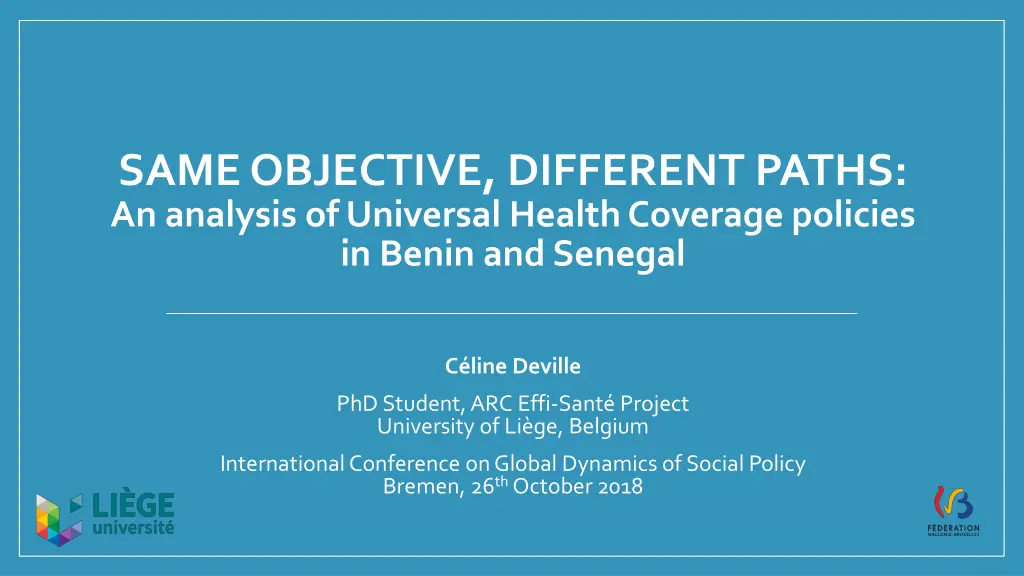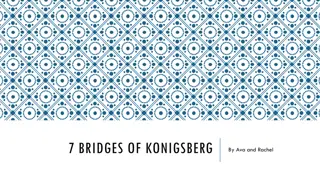
Analysis of Universal Health Coverage Policies in Benin and Senegal
Explore the strategies and challenges towards achieving Universal Health Coverage (UHC) in Benin and Senegal, comparing the policies implemented in each country. Delve into the unique approaches, commonalities, and differences in UHC initiatives, shedding light on the role of institutions, interests, and ideas influencing these reforms.
Uploaded on | 0 Views
Download Presentation

Please find below an Image/Link to download the presentation.
The content on the website is provided AS IS for your information and personal use only. It may not be sold, licensed, or shared on other websites without obtaining consent from the author. If you encounter any issues during the download, it is possible that the publisher has removed the file from their server.
You are allowed to download the files provided on this website for personal or commercial use, subject to the condition that they are used lawfully. All files are the property of their respective owners.
The content on the website is provided AS IS for your information and personal use only. It may not be sold, licensed, or shared on other websites without obtaining consent from the author.
E N D
Presentation Transcript
SAMEOBJECTIVE, DIFFERENT PATHS: An analysis of Universal HealthCoverage policies in Benin andSenegal C line Deville PhD Student, ARC Effi-Sant Project University of Li ge, Belgium International Conference on Global Dynamics of Social Policy Bremen, 26thOctober 2018
A central objective in the current global agenda (WHO 2005, UN 2012, SDG 2015) Universal HealthCoverage The most powerful concept that public health has to offer (M. Chan, 2010) Ensuring that all people obtain the health services they need without suffering financial hardship when paying for them (WHO s website) No one-size-fits-all approach to UHC (WB & WHO) ; all countries must make choices and trade-offs (WHO, 2010) Prepayment and pooling mechanisms Unless it is clearly understood, [it] can be used to justify practically anyheath financing reform or scheme (Kutzin, 2013 : 602) A frame of objective (r f rentiel d objectif) (Nauleau et al. 2013) This contrasts with travelling models (Olivier de Sardan et al. 2017) and provides room of manoeuvre to design national policies
How is this broad concept of UHC understood and translated in the national arena of two West-African countries that have quite similar health history and challenges ? What are the commonalities and differencesbetween the Beninese and Senegalese strategies to achieve UHC? How can the 3i (institutions, interests, ideas) shed light on these processes and choices ? (Palier & Surel, 2005)
An overview of UHC policies in Benin and Senegal Couverture Maladie Universelle (CMU) in Senegal From RAMU to ARCH in Benin RAMU was launched by Y. Boniin 2011 but never really implemented Launched in 2013 A law establishing RAMU (as compulsory) was adopted in December 2015 Central reform : Decentralization of health insurance through community-based health insurance (CBHI): In 2016, the newly elected president, P. Talon, decided to drop RAMU in order to implement a new project (ARCH). One local authority, one CBHI scheme This project is aimed at the poorest, with 4 branches : Health insurance, retirement planning, microcredit and occupational training. Contributions (7000 FCFA) are half (or fully) subsidized by the state 46% of the population is covered (included by exemption policies). 16% of the population through CBHI, but 2/3rd of them are fully subsidized (ACMU, 2017). The implementation has been postponed several times, and the project seems uncertain today. A new national agency should be created, and its management delegated to an insurance company from the private sector Draft of UHC bill is currently discussed
The role of ideas on UHC reforms (1/2) Health care systems [ ] are known as a competitive market-place for ideas (B land, 2010 : 622) According to Fox & Reich (2015 : 1034), the design of health reform is influenced by the policy ideas that are present at a given historical moment and the actors (often behind the scenes) that are actively promoting those models However, this ideational analysis should not hide the interests embedded to ideas, as well as the pre-existing health financing policies and projects, and the rules of the formulation and decision-making process.
The role of ideas on UHC reforms (2/2) The choice of public-private partnership (PPP) in Benin The choice of CBHI schemes in Senegal A coalition of national and international actors matching CBHI as a solution to the problem of UHC achievement: Lobbying towards the ministry of Health and during the presidential campaign Formulation process under the supervision (or even the control) and significant influence of the Presidency, alongside technocrats ARCH described as Talon s societal project. It was already his idea as a presidential candidate [ARCH Team, Benin] Prominent role of Senegalese experts working for AbtAssociates, acting as policy entrepreneurs PPP, strong reforms for good governance and well-inspired and skilled leaders are indeed core ideas of his program Progressive decline of this coalition CBHI are not explicitly mentioned in the bill draft and alternative models are considered The strategies rest on totally different ideas or ideologies (communauty vs. n o-liberal) UHC reforms are strongly linked to the Presidency in both countries The Beninese and Senegalese government also have totally different ideas about mandatory health insurance and its feasibility.
Fragmented reforms, path dependency and the role of institutions (1/2) In both countries, UHC reforms are primarily about expanding coverage to the population excluded from pre-existing social security schemes. We had IPM and we had to supplement the system with what is missing. That s the difference. So people have thought, CBHI schemes already existed in Senegal, but it was not really developed. And we considered that, for the excluded ones from the formal system, CBHI could be a good model, aren t they? [CMU Agent, Senegal] Path dependency: past policies also set up institutions that can place countries on a certain path, which is subsequently difficult to change (Fox & Reich, 2015: 1023). New schemes are created to cover the rural and informal workers, as well as the indigents , and pre-existing schemes are saved or reformed fragmentation ( Cross-subsidization and equity)
Fragmented reforms, path dependency and the role of institutions (2/2) Institutions shape interests : radical change is rare largely because of the vested interests that policies create over time (B land, 2010b : 105): Institutions Interests Maybe it will progress towards one universal basic scheme, but people have benefits they are not ready to lose. There are possibilities of extraordinary resistances, and a risk that ARCH would never start. [ ] Even between us, we had virulent debates. [ARCH Team, Benin] and decisions-makers perception of what is possible to achieve (Fox & Reich, 2015): These are difficult questions because it affects interests. [ ] One very complicated question in this group was the management unit of the different schemes. Some people insisted so that the creation of a unified institution to be at very long-term. We decided to be pragmatic [CMU Agent, S n gal] Ideas
Interests, strategic advocacy and positioning around UHC reforms Interests can be analysed through their embeddedness in ideas and institutions. However, the analysis of interests per se, through the action of strategic groups, is instructive as well: UHC policies mobilize a lot of resources that can be fought for Conflicts about the supervision of UHC policies, for which different ministries or agencies competed. If strategic groups interests are in danger, it could lead to the boycott of the reform (e.g. by the providers at the implementation stage). It is also the case if the reform is in contradiction with their ideas (e.g. free care). Other stakeholders advocate to gain or maintain their position in the institutional architecture of UHC reforms, depending on their interests (e.g. CBHI schemes, insurance companies or other health financing program managers)
What about vertical interdependencies ? Momentum around UHC: Multiple donors are willing to get involved in UHC reforms and support the national processes Each partner come with his own ideas and tools (e.g. World Bank : targeting process) Some of these ideas can compete (e.g. AbtAssociates vs. Belgian cooperation in Senegal) They also decide to finance some strategies rather than other ones, in accordance to their ideas, their interests, the funds available at the moment. They also can decide not to finance it. In Benin, it seems like no agreement was found about financing, while the ARCH project expects 90% of external funds ! The national party often complains about the lack of synergy, alignment and harmonization between international partners while some of these partners have the feeling that the state is taking advantage and, in some case, even causes this, as a strategy to draw as many funds as possible.
Conclusions Despite quite similar health histories and challenges, these countries have chosen different paths on the road to UHC, but they also have common features. Institutions, interests and ideas can be used in a complementary way, as they shed light on different choices or stages of UHC reforms. UHC strategies are highly political matters, as they involve multiple stakeholders with competing interests and ideas. They are also developed in a context that matters ! These reforms are the product of aggregation logics , progressively elaborated during repeated interactions (Palier & Surel, 2005) between stakeholders. The broad and consensual conceptualization of the objective of UHC, its polysemy , is what makes it so powerful , but also results in incremental reforms, sedimentedand fragmented systems that contrast with the universalistic goal. The citizensand beneficiaries are poorly represented in these processes and their perceptions and interests hardly ever questioned. The possibility of a non-demand (Warin, 2016) and the reasons underpinning it should be taken into consideration, so as to develop relevant policies.
References Agence de la CMU. (2017, mars). Mise en uvre de la couverture maladie universelle: rapport d activit s de l ann e 2016. Minist re de la Sant et de l Action Sociale, R publique du S n gal. B land, D. (2010). Policy Change and Health Care Research. Journal of Health Politics, Policy and Law, 35(4), 615-641. https://doi.org/10.1215/03616878-2010-019 Bierschenk, T., & Olivier de Sardan, J.-P. ( d.). (2014). States at work: dynamics of African bureaucracies. Leiden ; Boston: Brill. Fox, A. M., & Reich, M. R. (2015). The Politics of Universal Health Coverage in Low-and Middle-Income Countries: A Framework for Evaluation and Action. Journal of Health Politics, Policy and Law, 40(5), 1023-1060. https://doi.org/10.1215/03616878-3161198 Kutzin, J. (2013). Health financing for universal coverage and health system performance: concepts and implications for policy. Bulletin of the World Health Organization, 91(8), 602-611. https://doi.org/10.2471/BLT.12.113985 Nauleau, M., Destremau, B., & Lautier, B. (2013). En chemin vers la couverture sanitaire universelle : Les enjeux de l int gration des pauvres aux syst mes de sant . Revue Tiers Monde, 215(3), 129. https://doi.org/10.3917/rtm.215.0129 Olivier de Sardan, J.-P., Diarra, A., & Moha, M. (2017). Travelling models and the challenge of pragmatic contexts and practical norms: the case of maternal health. Health Research Policy and Systems, 15(S1). https://doi.org/10.1186/s12961-017-0213-9 Palier, B., & Surel, Y. (2005). Les trois I et l analyse de l tat en action. Revue fran aise de science politique, 55(1), 7. https://doi.org/10.3917/rfsp.551.0007 Warin, P. (2016). Le non-recours aux politiques sociales. Presses universitaires de Grenoble. World Bank, & World Health Organization. (n.d.). UHC in Africa : A Framework for Action. World Health Organization. (2010). The World health report: health systems financing: the path to universal coverage. Geneva.




















